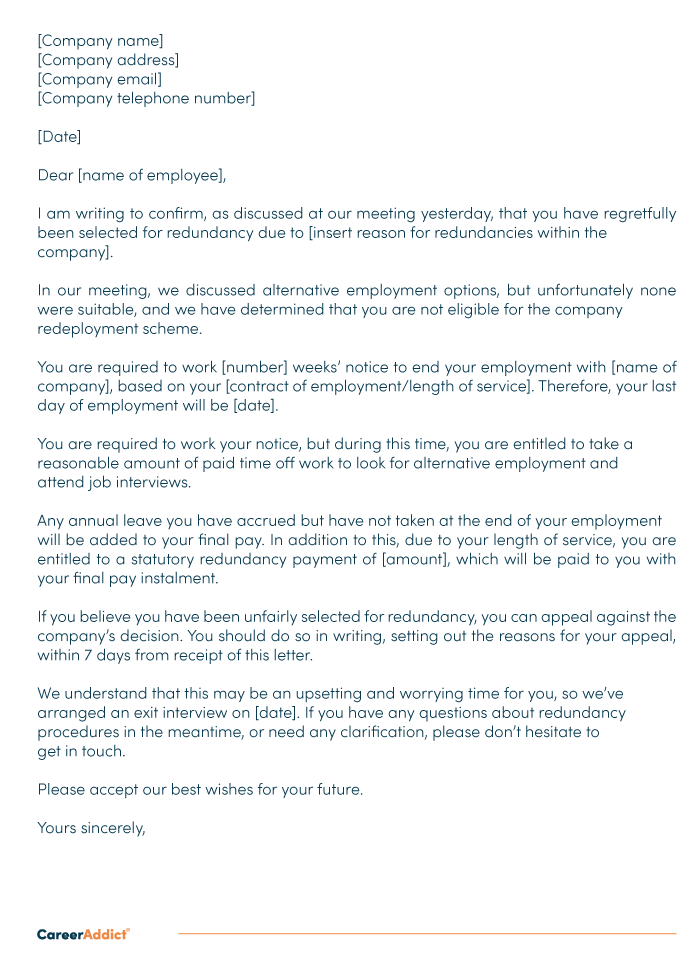Who Pays Redundancy Money? A Comprehensive Overview for Employers and Employees
Who Pays Redundancy Money? A Comprehensive Overview for Employers and Employees
Blog Article
Examining the Systems of Business Redundancy and Its Impact on Staff Member Morale
The systems behind the decision-making processes leading to staff member redundancies can have far-reaching results on spirits within an organization. By discovering the elaborate interaction between company downsizing methods, worker reactions, and business resilience, a clearer photo emerges of the elaborate dancing in between service requirements and human feelings.

Impact of Business Redundancy on Spirits
The significant rise in firm redundancies has had an extensive influence on employee morale in recent months. As companies browse financial challenges, the choice to downsize or reorganize operations typically causes heightened levels of uncertainty and anxiousness among staff members. The concern of losing one's task, coupled with the increased work for staying staff, can develop a difficult job atmosphere that moistens spirits.
Employees that witness their colleagues being laid off may experience survivor regret, really feeling thankful for their very own position while likewise facing feelings of despair and insecurity. This emotional chaos can adversely affect performance and engagement, as people have a hard time to concentrate amidst the turmoil.
Moreover, the absence of transparency surrounding the redundancy process can better erode trust fund and self-confidence in firm leadership. if a company goes bust who pays redundancy. When workers really feel uninformed or overlooked during such rough times, their commitment to the organization decreases, and morale plummets
Variables Leading to Firm Downsizing
Amidst economic uncertainties, business often deal with the difficult job of determining and dealing with crucial variables that demand downsizing their operations. One substantial element leading to company downsizing is economic instability. When a firm experiences financial difficulties such as declining revenues, increasing expenses, or extreme financial debt, downsizing might come to be a required step to make sure the company's sustainability. Technical improvements likewise play a critical function in business scaling down. Automation and the fostering of a lot more efficient procedures can result in a lowered requirement for human labor, resulting in labor force reductions. Market variations and modifications in consumer choices are added aspects that can trigger downsizing efforts. Firms should adjust to developing market problems to stay affordable, and this sometimes involves restructuring procedures and reducing workforce dimension. Additionally, mergings and procurements can cause redundancies, motivating business to scale down to remove overlapping duties and simplify procedures. Overall, a combination of financial obstacles, technological changes, market characteristics, and business adjustments commonly drive firms towards downsizing as a tactical decision.
Strategies for Alleviating Negative Impacts
Variables leading to company scaling down require the application of critical procedures intended at alleviating the adverse impacts on both the organization and its workers. Clear interaction aids workers understand the reasons behind the redundancy, decreases unpredictability, and reduces anxiousness.
In addition, compensating the devotion and acknowledging and difficult job of visit their website staff members who stay can help keep motivation and avoid a decrease in morale. By implementing these techniques, business can navigate scaling down with more empathy and reduce the negative influence on employee morale.
Employee Durability In The Middle Of Redundancy
Navigating with periods of redundancy, workers are often required to show strength in the face of business modifications. Staff member resilience in the middle of redundancy refers to the capability of individuals to adjust, deal, and recover from the difficulties postured by potential task loss. This resilience can materialize in numerous methods, such as preserving a favorable mindset, looking for brand-new possibilities, upskilling, and networking to enhance employability.
Durable staff members typically exhibit a growth frame of mind, checking out problems as short-term and concentrating on understanding and growth. They are aggressive in handling their feelings, looking for support when required, and preserving a sense of positive outlook concerning the future. Furthermore, resistant workers are most likely to welcome modification, see it as a chance for expert and individual growth, and continue to be fully commited to their occupation development despite the unpredictability produced by redundancy.
Organizations can support worker strength through clear communication, supplying accessibility to resources for upskilling and re-training, providing career counseling services, and acknowledging and rewarding workers that show resilience throughout difficult times. By cultivating a culture of strength, business can help staff members navigate redundancy better and arise stronger from the experience.
Building an Encouraged Labor Force Post-Redundancy
In the results of organizational restructuring and employee durability among redundancy, cultivating a motivated workforce becomes paramount for the business's future success and staff member wellness. Developing an inspired workforce post-redundancy needs a calculated strategy that concentrates on reconstructing depend on, boosting find out morale, and re-engaging staff members. Communication plays an essential role in this procedure, as open and transparent dialogue can aid employees comprehend the reasons behind the redundancies and the firm's vision moving on.
Supplying opportunities read this post here for employee advancement and growth is another important facet of developing a motivated workforce post-redundancy. Providing training programs, mentorship chances, and career improvement potential customers can aid staff members feel valued and purchased their future within the organization - if a company goes bust who pays redundancy. Acknowledging and compensating workers for their payments, specifically throughout challenging times, can also improve morale and inspiration

Conclusion
Finally, firm redundancy can have a substantial influence on employee morale, bring about decreased inspiration and task contentment. Understanding the elements that add to scaling down and executing strategies to reduce negative effects is essential for keeping worker durability throughout challenging times. By cultivating an encouraging job atmosphere and providing chances for specialist growth, firms can rebuild an inspired workforce post-redundancy.
The significant rise in firm redundancies has had a profound impact on employee spirits in recent months. By carrying out these techniques, firms can browse downsizing with more compassion and minimize the unfavorable influence on staff member morale.
In the results of organizational restructuring and employee resilience in the middle of redundancy, promoting an inspired workforce ends up being critical for the company's future success and worker health. Communication plays a pivotal function in this process, as transparent and open dialogue can aid workers comprehend the factors behind the redundancies and the business's vision relocating onward.
In conclusion, business redundancy can have a substantial effect on staff member spirits, leading to lowered inspiration and job satisfaction. (if a company goes bust who pays redundancy)
Report this page